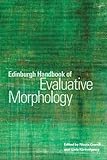Edinburgh Handbook of Evaluative Morphology / Nicola Grandi, Livia Kortvelyessy.
Material type: TextPublisher: Edinburgh : Edinburgh University Press, [2022]Copyright date: ©2015Description: 1 online resource (752 p.)Content type:
TextPublisher: Edinburgh : Edinburgh University Press, [2022]Copyright date: ©2015Description: 1 online resource (752 p.)Content type: - 9780748681747
- 9780748681754
- 415.9 23
- P241 .E35 2015
- online - DeGruyter
- Issued also in print.
| Item type | Current library | Call number | URL | Status | Notes | Barcode | |
|---|---|---|---|---|---|---|---|
 eBook
eBook
|
Biblioteca "Angelicum" Pont. Univ. S.Tommaso d'Aquino Nuvola online | online - DeGruyter (Browse shelf(Opens below)) | Online access | Not for loan (Accesso limitato) | Accesso per gli utenti autorizzati / Access for authorized users | (dgr)9780748681754 |
Frontmatter -- Contents -- Illustrations -- Tables -- Abbreviations -- Contributors -- PART I -- 1 Introduction: why evaluative morphology? -- 2 The semantics of evaluative morphology -- 3 Evaluative morphology and pragmatics -- 4 Word-formation processes in evaluative morphology -- 5 Evaluative morphology and language universals -- 6 The place of evaluation within morphology -- 7 Evaluative morphology and number/gender -- 8 Evaluative morphology and aspect/actionality -- 9 Evaluative morphology and sociolinguistic variation -- 10 Evaluative morphology and language acquisition -- 11 Evaluative morphology in a diachronic perspective -- 12 Evaluative morphology in sign languages -- 13 Evaluative morphology in pidgins and creoles -- PART II -- 14 Evaluative morphology from a cross-linguistic perspective: Introduction to the descriptive chapters -- 15 Eurasia -- 15.1 Basque -- 15.2 Catalan -- 15.3 Georgian -- 15.4 Hungarian -- 15.5 Israeli Hebrew -- 15.6 Ket -- 15.7 Latvian -- 15.8 Luxembourgish -- 15.9 Modern Greek -- 15.10 Nivkh -- 15.11 Persian -- 15.12 Slovak -- 15.13 Swedish -- 15.14 Tatar -- 15.15 Telugu -- 15.16 Udihe -- 16 South-East Asia and Oceania -- 16.1 Apma -- 16.2 Chinese -- 16.3 Lisu -- 16.4 Muna -- 16.5 Tagalog -- 16.6 Tibetan -- 16.7 Yami -- 17 Australia and New Guinea -- 17.1 Dalabon -- 17.2 Iatmul -- 17.3 Jingulu -- 17.4 Kaurna -- 17.5 Rembarrnga -- 17.6 Warlpiri -- 17.7 Yukulta and its relatives Kayardild and Lardil -- 18 Africa -- 18.1 Berber -- 18.2 Classical and Moroccan Arabic -- 18.3 Ewe -- 18.4 Kɔnni -- 18.5 Sεlεε -- 18.6 Shona -- 18.7 Somali -- 18.8 Zulu -- 19 North America -- 19.1 Cabécar -- 19.2 Choctaw -- 19.3 Dena'ina -- 19.4 Huautla Mazatec -- 19.5 Huave -- 19.6 Inuktitut -- 19.7 Plains Cree -- 19.8 Slavey (Dene) and other Athabaskan Languages -- 20 South America -- 20.1 Jaqaru -- 20.2 Kwaza -- 20.3 Lule -- 20.4 Toba -- 20.5 Wichi -- 20.6 Yurakaré -- References -- Language index -- Subject index -- Name index
restricted access online access with authorization star
http://purl.org/coar/access_right/c_16ec
Reviews and debates the latest theoretical approaches to evaluative morphologyGBS_insertPreviewButtonPopup(['ISBN:9780748681747','ISBN:9780748681754']);With examples drawn from over 200 world languages, this ground-breaking volume presents a state-of-the-art overview of evaluative morphology. Offering an innovative approach to major theoretical questions, the Edinburgh Handbook analyses the field from a cross-linguistic perspective, considering semantic, pragmatic and sociolinguistic aspects, as well as word-formation processes and evaluative morphology acquisition. Complementing the synchronic approach with a diachronic perspective, this study establishes a picture of intriguing diversity in evaluative morphology manifestations, and offers a comprehensive analysis of the situation in dozens of languages and language families.Divided into 2 distinct parts, the handbook begins with 13 chapters discussing evaluative morphology in relation to areas such as pragmatics, semantics, linguistic universals and sociolinguistics. The second part is comprised of descriptive chapters, broken into the following subsets: Eurasia, South- East Asia and Oceania, Australia-New Guinea, Africa, North America and South America.The Handbook features 3 separate indexes detailing languages, names, subjects."
Issued also in print.
Mode of access: Internet via World Wide Web.
In English.
Description based on online resource; title from PDF title page (publisher's Web site, viewed 02. Mrz 2022)


